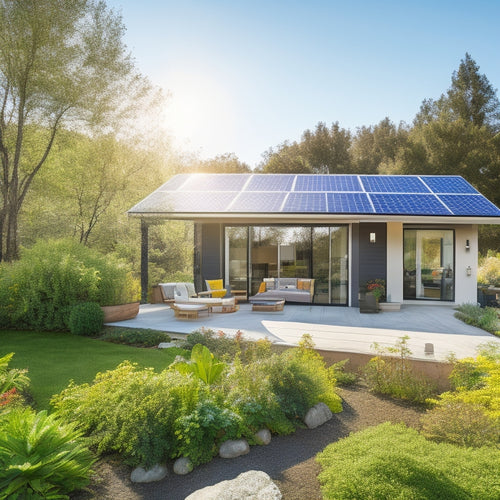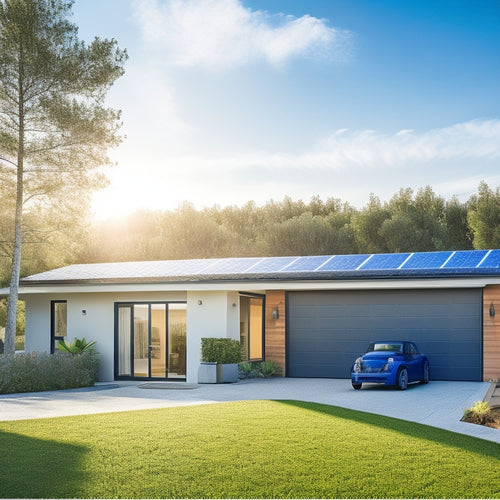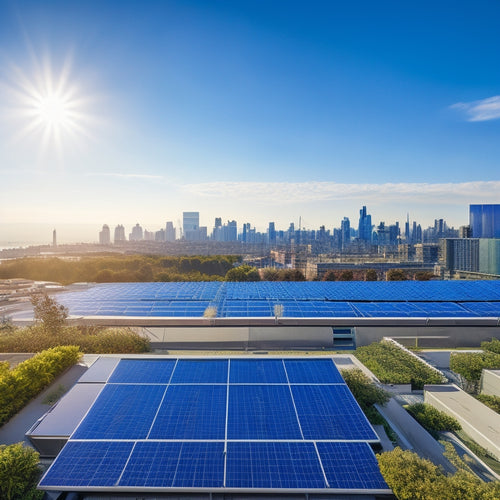
Solar Panel Solar Panel Installation Requirements
Share
When planning your solar panel installation, you'll need to conduct a thorough site assessment to determine the ideal panel location, evaluate solar irradiance, and identify potential shading obstructions. You'll also need to assess your roof's size, condition, and structural integrity to guarantee it can support the additional weight of the panels. Additionally, you'll need to meet local energy efficiency standards, comply with building codes, and evaluate your electrical panel's capacity to handle the increased power. Moreover, you'll need to choose the right inverter and mounting system, verify proper grounding and bonding, obtain necessary permits, and maneuver through net metering and interconnection agreements. As you move forward with your installation, you'll uncover more subtleties to contemplate that can make all the difference in your solar panel system's performance.
Key Takeaways
- Conduct a solar site analysis to determine the ideal panel location and assess solar irradiance, shading, and electrical infrastructure.
- Ensure the roof size, condition, and structural integrity can support the solar panel system, with regular maintenance essential for longevity.
- Comply with local energy efficiency standards, regulations, and building codes to qualify for incentives and ensure safety and structural integrity.
- Select the appropriate electrical panel, inverter, and mounting system for the solar panel installation, considering factors like energy goals and local building codes.
- Obtain necessary permits, pass inspections, and comply with utility company rules for net metering, interconnection, and grid connection.
Site Assessment and Evaluation
During the initial stages of solar panel installation, a thorough site evaluation and analysis are vital to guarantee a successful project.
You'll need to conduct a solar site analysis to identify the ideal location for your solar panels. This involves evaluating the site's solar irradiance, which is the amount of sunlight it receives throughout the year.
You'll also need to perform a shading evaluation to determine if any obstacles, such as trees or buildings, will cast a shadow on your solar panels. This is essential because shading can greatly reduce your system's energy output. The assessment will help you determine the best panel layout and configuration to minimize shading effects.
Additionally, you'll need to evaluate the site's electrical infrastructure to confirm it can support the solar panel system. This includes evaluating the existing electrical service, wiring, and breaker panels to ensure they can handle the increased electrical load.
Roof Size and Condition
When evaluating your roof's suitability for solar panels, you'll need to contemplate whether it has sufficient space to accommodate them.
You'll also need to assess the roof's age and condition, as damaged or aging roofs may not be suitable for solar panel installation.
A thorough evaluation of these factors will help determine whether your roof can support a solar panel system.
Roof Space Availability
Most residential roofs have ample space to accommodate solar panels, but it is essential to assess your roof's size and condition before installation. You need to guarantee that your roof has enough space to fit the required number of solar panels to meet your energy needs.
To determine the feasibility of a solar panel installation, consider the following factors:
| Roof Space Factor | Description |
|---|---|
| Roof Size | Measure your roof's size to determine the available space for solar panels. A larger roof provides more space for a larger solar array. |
| Shading Analysis | Conduct a shading analysis to identify areas on your roof that receive partial or full shade. This helps optimize panel placement for maximum energy output. |
| Orientation Optimization | Assess your roof's orientation (south-facing, east-facing, etc.) to optimize panel placement for maximum energy output. |
Roof Age and Damage
Take stock of your roof's age and condition to ascertain it's sturdy enough to support the weight of solar panels. You don't want to invest in solar energy only to find out your roof can't handle the added weight. A roof's age plays a significant role in determining its suitability for solar panels. Typically, roofs with a lifespan of 10-15 years or less may not be ideal for solar installations.
Roof damage, such as cracks, curled or buckled shingles, and signs of wear around chimneys and vents, can also compromise the structural integrity of your roof.
Regular roof maintenance is vital to make sure your roof remains in good condition. Inspect your roof regularly for signs of damage and address them promptly. This won't only extend your roof's lifespan but also guarantee the solar longevity of your system.
A sturdy roof is fundamental for a successful solar panel installation. Don't risk compromising your solar investment by neglecting your roof's condition. By evaluating your roof's age and condition, you'll be able to determine if it's ready for solar panels or if repairs are needed before installation.
Energy Efficiency Standards
Each state and local government sets its own energy efficiency standards for solar panel installations, ensuring that your system meets certain performance benchmarks.
These standards promote energy conservation practices, encouraging you to optimize your solar panel system's performance. By meeting these standards, you'll not only reduce your carbon footprint but also increase your system's lifespan and efficiency.
When installing solar panels, you'll need to evaluate the energy efficiency standards in your area. This might involve selecting high-efficiency solar panels, optimizing your system's design, and ensuring proper installation.
Meeting these standards can also make you eligible for renewable energy incentives, such as tax credits or rebates. These incentives can greatly reduce the upfront cost of your solar panel installation, making it more accessible and affordable.
Local Building Codes Compliance
Your solar panel installation must also comply with local building codes, which regulate the safety and structural integrity of your system. These codes vary by region, so it's important to research the specific requirements for your area.
You'll need to confirm that your system meets local regulations regarding installation, maintenance, and inspection.
Additionally, you'll need to take into account zoning restrictions, which may impact the size and placement of your solar panels. For example, some areas may have rules about the percentage of roof space that can be covered by solar panels or the distance between panels and property lines.
Failure to comply with these regulations can result in fines, penalties, or even the removal of your solar panel system.
To avoid these issues, it's vital to work with a qualified solar panel installer who's experience maneuvering through local building codes and zoning restrictions.
They'll help you design and install a system that meets all necessary requirements, guaranteeing a safe and efficient solar panel installation that meets your energy needs.
Electrical Panel Upgrades Needed
In many cases, your home's existing electrical panel may not be equipped to handle the added power generated by your new solar panel system, necessitating an upgrade to guarantee safe and efficient energy distribution.
This is especially true if your current panel is old or has been modified extensively over the years. Upgrading your electrical panel assures that your solar panel system can operate at its full potential, providing you with the maximum amount of power and energy savings.
-
Your electrical panel must be able to handle the increased power output from your solar panel system, which may require a higher ampere rating.
-
A modern electrical panel with advanced energy management capabilities can optimize energy distribution, reducing waste and increasing efficiency.
-
You may need to install a new main service panel or upgrade your existing one to accommodate the solar panel system's electrical connections.
-
Battery storage integration requires a specialized electrical panel that can handle the unique power demands of energy storage systems.
-
A licensed electrician should assess your electrical panel to determine the necessary upgrades for a safe and efficient solar panel installation.
Inverter and Mounting Options
With your electrical panel upgraded to handle the added power from your solar panel system, it's time to focus on utilizing that energy efficiently. This is where inverter and mounting options come into play.
You'll need an inverter to convert the DC power generated by your solar panels into AC power, which is usable in your home. There are three main inverter types to evaluate: string inverters, microinverters, and power optimizers. String inverters are the most common, but microinverters and power optimizers offer more flexibility and monitoring capabilities.
When it comes to mounting systems, you'll need to decide between roof-mounted, ground-mounted, and tracking systems. Roof-mounted systems are the most popular, but ground-mounted systems can be more efficient and easier to maintain.
Tracking systems, which adjust to follow the sun's movement, can increase energy production by up to 45%. Assess factors like your roof's size and condition, local building codes, and your energy goals when choosing the right mounting system for your solar panel installation.
Grounding and Bonding Requirements
Electrical safety is paramount in solar panel installations, and grounding and bonding requirements play an essential role in preventing electrical shocks and fires. You need to guarantee that your solar panel system is properly grounded and bonded to protect people and equipment from electrical hazards.
-
Grounding techniques involve connecting the solar panel system to the earth to prevent voltage buildup and provide a safe path to ground for fault currents.
-
You'll need to use bonding materials that meet the requirements of the National Electric Code (NEC) to guarantee a reliable and durable connection.
-
The grounding system should be designed to handle the maximum possible fault current and withstand corrosive environments.
-
You must also verify that all metallic components, including the solar panels, mounting hardware, and inverters, are properly bonded to the grounding system.
-
Regular inspection and testing of the grounding and bonding system are vital to confirm its integrity and reliability.
Permits and Inspection Process
Before commencing a solar panel installation, you must obtain the necessary permits and undergo a rigorous inspection process to confirm compliance with local building codes and safety standards.
You'll need to secure permits from your local government, which may include electrical permits, building permits, and zoning permits. The specific permit types and requirements vary depending on your location, so be certain to research the regulations in your area.
The inspection timeline typically involves a series of checks at different stages of the installation process.
First, a pre-installation inspection verifies that your roof is structurally sound and can support the weight of the solar panels.
After installation, a post-installation inspection confirms that the system is installed correctly and meets safety standards.
Finally, a final inspection and approval from your local authorities are necessary before you can turn on your solar panel system.
Net Metering and Interconnection
When you're installing a solar panel system, you'll need to take into account net metering and interconnection requirements, which vary by utility company and region.
You'll need to verify your system meets system size limits, typically ranging from 10 kW to 1 MW, to qualify for net metering programs.
Additionally, you'll need to comply with your utility company's rules, which may include specific equipment requirements, application processes, and fees.
System Size Limits
Your solar panel system's size is vital in determining its net metering and interconnection eligibility. The system capacity and energy output will be evaluated to guarantee you're not producing more energy than you can consume. This is significant because utility companies have specific requirements for system size limits to maintain grid stability.
Here are the key considerations for system size limits:
-
System capacity: Your system's capacity shouldn't exceed 150% of your maximum annual energy consumption.
-
Energy output: Your system's energy output shouldn't exceed 150% of your maximum annual energy consumption.
-
Utility company limits: Some utility companies have specific system size limits, so it's important to check with them before installation.
-
Grid stability: The system size limit guarantees that your system doesn't produce more energy than the grid can handle.
-
Net metering: System size limits affect your net metering eligibility, which allows you to sell excess energy back to the grid.
Utility Company Rules
As you prepare to install your solar panel system, understanding the utility company rules governing net metering and interconnection is vital. These rules vary by state and utility company, so it's important to research and understand the specific requirements in your area.
Net metering allows you to generate your own electricity and export any excess to the grid, offsetting your energy consumption and reducing your utility bills. To take advantage of net metering, you'll need to establish an interconnection agreement with your utility company, which outlines the terms and conditions of your grid connection.
Your utility company will require a bi-directional meter to measure the electricity you produce and consume. You may also need to install a grid connection device to guarantee safe and reliable operation.
Additionally, you should be aware of any solar incentives offered by your utility company, such as rebates or special tariffs for solar customers. By understanding these utility company rules, you can maximize the benefits of your solar panel system and facilitate a smooth shift to renewable energy.
Frequently Asked Questions
Can I Install Solar Panels on a Metal or Clay Tile Roof?
You can install solar panels on a metal or clay tile roof, but you'll need to take into account installation factors, such as weight and structural integrity, to guarantee roof compatibility and a successful, efficient energy-harvesting system.
How Long Does a Typical Solar Panel Installation Take?
You'll typically spend 2-5 days overseeing the installation process, with the actual installation timeline taking around 1-3 days, depending on the complexity of your roof and the number of panels being installed.
Will Solar Panels Increase My Property Value?
You'll likely see an increase in property value, as solar panels provide significant financial benefits, which are reflected in your property assessment, increasing your home's worth and appeal to potential buyers if you decide to sell.
Can I Install Solar Panels Myself to Save Money?
You're considering a DIY solar installation to save on costs, like John, who saved $5,000 by doing it himself, but be aware that improper installation can lead to reduced efficiency and even safety hazards, so weigh the risks before taking on the project.
Are Solar Panels Covered by a Manufacturer's Warranty?
You'll be relieved to know that most solar panels come with a manufacturer's warranty, typically covering warranty coverage for 25 years or more, ensuring your investment in solar panel durability and performance is protected.
Conclusion
Now that you've maneuvered through the intricate terrain of solar panel installation requirements, you're ready to tap into the power of the sun with confidence. By dotting every "i" and crossing every "t", you'll guarantee a seamless and compliant installation process. As you commence this renewable energy expedition, remember that every careful detail is a vital step towards a brighter, more sustainable future.
Related Posts
-

Green Home Improvements Using Solar Power
Investing in solar power alters your home into a sustainable haven while slashing energy costs. You can greatly reduc...
-

Solar Energy Storage Options for Homes
When considering solar energy storage options for your home, you'll find several effective solutions. Battery systems...
-

Business Solar Investments for Cost-Effective Sustainability
Investing in solar energy is a smart move for your business, providing a solid foundation for cost-effective sustaina...


